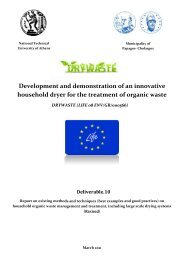MOROCOMP (LIFE TCY05/MA000141) - Unit of Environmental ...
MOROCOMP (LIFE TCY05/MA000141) - Unit of Environmental ...
MOROCOMP (LIFE TCY05/MA000141) - Unit of Environmental ...
Create successful ePaper yourself
Turn your PDF publications into a flip-book with our unique Google optimized e-Paper software.
Biochemical Oxygen Demand (BOD 5 ) is a measure <strong>of</strong> the amount <strong>of</strong> oxygen that<br />
bacteria will consume while decomposing organic matter under aerobic conditions.<br />
Biochemical oxygen demand is determined by incubating a sealed sample <strong>of</strong> water for<br />
five days and measuring the loss <strong>of</strong> oxygen from the beginning to the end <strong>of</strong> the test<br />
[39]. According to Trujillo et al. leachates originating from wastewater sludge<br />
composting processes are characterized by increased BOD 5 values reaching up to 70<br />
g/L [40]. The initial sample <strong>of</strong> leachates derived from the 1 st composting trial acquired<br />
an increased initial BOD 5 value <strong>of</strong> 50.9g/L on the 3 rd day. As the process develops the<br />
organic intermediate products undergo complete bioxidation to CO 2 while the non<br />
biodegradable or less susceptible to degradation compounds accumulate. Therefore<br />
the microbial activity gradually decreases and the used oxygen by the biological<br />
organisms in leachates is reduced as the process continuous. For this reason the BOD 5<br />
evolution during composting presented a downwards inclination and at the end <strong>of</strong> the<br />
process leachates had been reduced approximately 1/6 <strong>of</strong> the initial BOD 5 value.<br />
Leachates acquired at the initial stage <strong>of</strong> composting a light dark colour which was<br />
gradually becoming darker as composting was developing. This is indicative <strong>of</strong> the<br />
presents <strong>of</strong> humic/fulvic and other complex compounds which are dark coloured,<br />
hydrophilic organic compounds whose molecular weight varies from few hundreds to<br />
few thousands. Ammonium and nitrates in leachates followed the same pattern as the<br />
ammonium and nitrates <strong>of</strong> the substrate indicating that the composting process was<br />
well monitored since the conditions were in favor <strong>of</strong> nitrification. Ammonium ions<br />
concentration presented a steep increase during the first days <strong>of</strong> composting reaching<br />
to a maximum <strong>of</strong> 1985.06mg/L on the 7 th day. From that day onwards ammonium<br />
concentration kept reduced and on 23 rd day their concentration in leachates was<br />
450.84mg/L. Nitrates in leachates presented a significant increase throughout the<br />
duration <strong>of</strong> the 1 st trial. On the 3 rd day their concentration was limited at 34.05mg/L<br />
while on the 23 rd day it had been increased approximately 12 times reaching at<br />
687.51mg/L. Table 6 shows also that heavy metals such as Cd, Cr, Cu, Ni, Pb and Zn<br />
were present in leachates throughout the process. The metal concentrations were<br />
much below the indicative values for wastewater disposal as shown in Table 7.<br />
48










